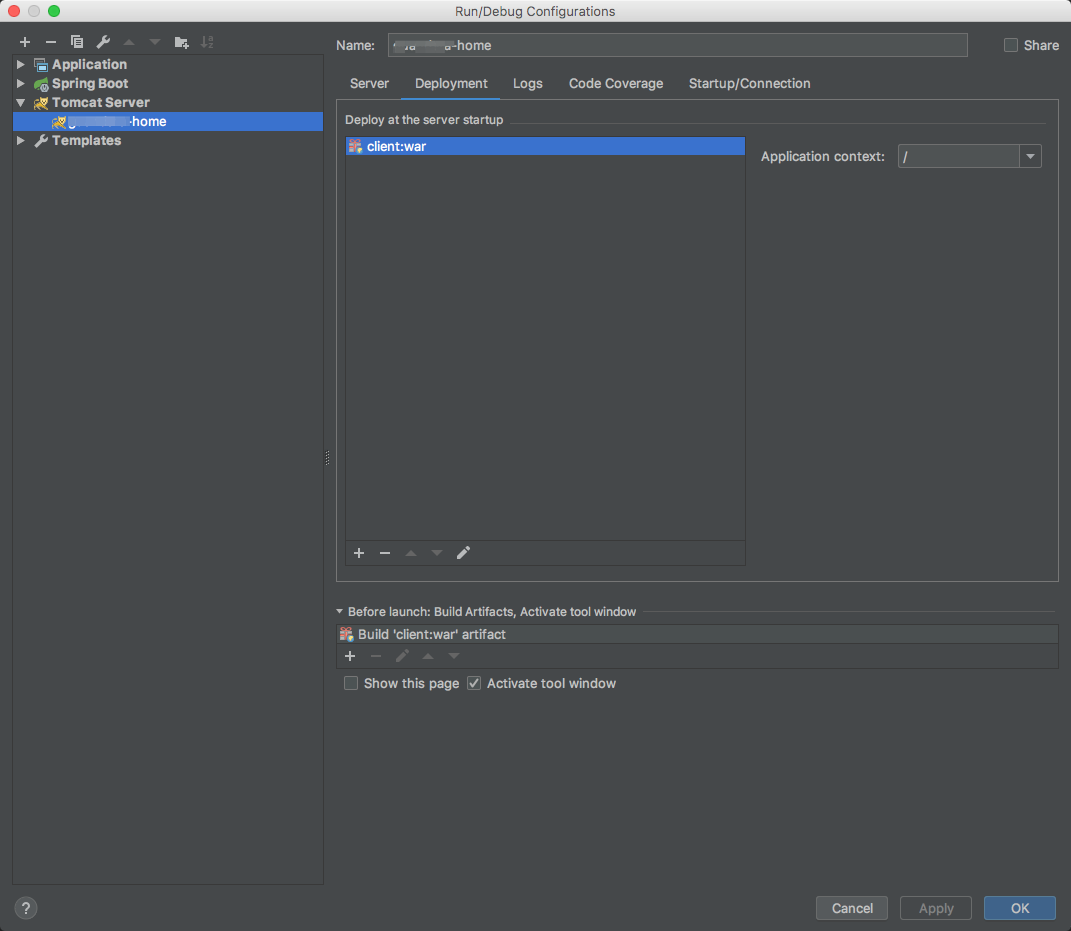花了半天时间终于成功,记录以备查阅。
一、第三方Tomcat部署
部署部分参考的是:把spring-boot项目部署到tomcat容器中
目标:把spring-boot项目按照平常的web项目一样发布到tomcat容器下
1. 修改打包形式
在pom.xml里设置 <packaging>war</packaging>
<groupId>com.study</groupId>
<artifactId>test</artifactId>
<version>0.0.1-SNAPSHOT</version>
<packaging>war</packaging>
2. 移除嵌入式tomcat插件
在pom.xml里找到spring-boot-starter-web依赖节点,在其中添加如下代码:
<dependency> <groupId>org.springframework.boot</groupId> <artifactId>spring-boot-starter-web</artifactId> <!-- 移除嵌入式tomcat插件 --> <exclusions> <exclusion> <groupId>org.springframework.boot</groupId> <artifactId>spring-boot-starter-tomcat</artifactId> </exclusion> </exclusions> </dependency>
3. 添加servlet-api的依赖
下面两种方式都可以,任选其一
<dependency> <groupId>javax.servlet</groupId> <artifactId>javax.servlet-api</artifactId> <version>3.1.0</version> <scope>provided</scope> </dependency>
<dependency> <groupId>org.apache.tomcat</groupId> <artifactId>tomcat-servlet-api</artifactId> <version>8.0.36</version> <scope>provided</scope> </dependency>
4. 修改启动类,并重写初始化方法
我们平常用main方法启动的方式,都有一个App的启动类,代码如下:
@SpringBootApplication public class Application { public static void main(String[] args) { SpringApplication.run(Application.class, args); } }
直接让启动类继承SpringBootServletInitializer,并覆盖configure()方法:
@SpringBootApplication public class Application extends SpringBootServletInitializer { @Override protected SpringApplicationBuilder configure(SpringApplicationBuilder builder) { // 注意这里要指向原先用main方法执行的Application启动类 return builder.sources(Application.class); } public static void main(String[] args) { SpringApplication.run(Application.class, args); } }
5. 打包部署
在项目根目录下(即包含pom.xml的目录),在命令行里输入: mvn clean package即可, 等待打包完成,出现[INFO] BUILD SUCCESS即为打包成功。 mvn clean package 命令可以按需要添加参数, -DskipTests 不执行测试用例,但编译测试用例类生成相应的class文件至target/test-classes下。 -Dspring.profiles.active=dev 如果配置了多环境,可以设置打包到哪个环境。 然后把target目录下的war包放到tomcat的webapps目录下,启动tomcat,即可自动解压部署。 最后在浏览器中输入 http://localhost:[端口号]/[打包项目名]/ 发布成功
二、IntelliJ IDEA下使用第三方Tomcat运行项目
1. 完成部署中的1,2,3,4步骤
2. 配置第三方Tomcat
IDEA上方工具栏:Run->Edit Configurations
打开配置界面,左边"+"号->Tomcat Server->Local
完成后如下所示

然后在Deployment中点击"+"号,选择client:war,这样每次server启动的时候都会去打包一次war包(个人理解),然后去运行war包。
然后保存就可以了,然后启动项目就运行起来了。
三、部署中遇到的问题
1. log4j.properties中使用了环境变量
log4j.appender.dailyFile.File=${catalina.base}/logs/guandata/log.log4j
在启动第三方Tomcat时,Tomcat会去环境变量中寻找叫CATALINA_HOME、CATALINA_BASE的环境变量,并将它们加入到Tomcat到系统变量中,这样我们就能在项目中使用它们了。
2. 部署后访问静态资源,访问路径URL中多了项目名,导致静态资源找不到
举例:
原本在springboot内置Tomcat中运行项目,资源访问路径URL类似于:http://localhost:8080/css/bootstrap.min.css 但是打包部署到第三方Tomcat中,Tomcat默认会在路径中加上项目名,类似于:http://localhost:8080/myproject/css/bootstrap.min.css 这样就导致了访问不到静态资源 404
原因:
由于在前端引用资源时使用了绝对路径:
<link href="/css/bootstrap.min.css" rel="stylesheet">
这样默认在 http://localhost:8080/css/bootstrap.min.css 下面寻找,因此,我们需要在前面加上项目名,但是写死的话万一改项目名就很麻烦,当然是有办法解决的。
解决:
1. 在Java后端定义一个拦截器,用来获取 request.getContextPath() 然后传到前端,request.getContextPath() 得到的是项目的根路径,具体参考:关于request.getServletPath(),request.getContextPath()的总结
1 @Component 2 public class CommonIntercepter implements HandlerInterceptor { 3 4 private final Logger logger = LoggerFactory.getLogger(this.getClass()); 5 6 @Override 7 public boolean preHandle(HttpServletRequest request, 8 HttpServletResponse response, Object handler) throws Exception { 9 return true; 10 } 11 12 @Override 13 public void postHandle(HttpServletRequest request, 14 HttpServletResponse response, Object handler, 15 ModelAndView modelAndView) throws Exception { 16 request.setAttribute("ctx", request.getContextPath()); 17 request.setAttribute("version", DateTimeUtils.currentTimeMillis()); 18 } 19 20 @Override 21 public void afterCompletion(HttpServletRequest request, 22 HttpServletResponse response, Object handler, Exception ex) 23 throws Exception { 24 25 } 26 27 28 }
2. 前端在静态资源访问url前加上${ctx!},注意我用的是freemarker模版
<link href="${ctx!}/css/bootstrap.min.css" rel="stylesheet"> <link href="${ctx!}/css/font-awesome.min.css" rel="stylesheet"> <link href="${ctx!}/css/plugins/bootstrap-table/bootstrap-table.min.css" rel="stylesheet"> <link href="${ctx!}/css/animate.css" rel="stylesheet"> <link href="${ctx!}/css/style.css" rel="stylesheet">
这样就能正确访问到静态资源啦。
3. 要注意给Tomcat/bin路径下的脚本权限,否则可能会出现不可预料的后果
sudo chmod 777 /Library/Tomcat/apache-tomcat-9.0.10/bin/*.sh